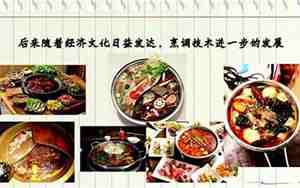火锅的历史

火锅,作为一种深受全球美食爱好者喜爱的特色烹饪方式,其历史源远流长,可以追溯到中国古老的饮食文化。据考古学家研究,火锅最原始的形式可能在公元前的战国时期就已经出现,但最广为人知的发展与普及则是在中国的明清两代。
火锅的原始形式可能与北方的“涮锅”相似,人们将热汤放入锅中,将切好的肉类、蔬菜等食物放入其中烹煮。到了唐朝,火锅开始加入了更多的配料,如豆皮、豆腐等,而且火锅底料也开始多样化,如牛骨汤、鸡鸭汤等,使得火锅的味道更加丰富。
到了明清时期,火锅已经成为人们社交活动中的重要组成部分。尤其是清朝,火锅在宫廷和民间都有极高的地位,成为节日家宴、朋友聚会的常见菜肴。著名的“麻辣火锅”和“鸳鸯火锅”等特色火锅也在这个时期发展出来,麻辣火锅的起源可以追溯到四川地区,而鸳鸯火锅则是将麻辣和清汤两种口味分开,以满足不同口味的人。
火锅的历史是一个随着时间和地域变化而不断丰富的过程,它不仅是一种烹饪方式,更是一种生活习俗、一种文化的传承。现在,火锅已经超越了地域界限,成为中国乃至全球餐饮文化中不可或缺的一部分。
火锅的历史英文介绍
Fried Pot, commonly known as hot pot, has a rich history dating back centuries in China. Its origins can be traced to China's ancient times, particularly during the Warring States and Ming-Qing dynasties, although the earliest forms might have resembled the modern-day "涮锅", where raw ingredients were cooked in a boiling broth.
During the Tang Dynasty, the concept evolved, and hot pot began to include a wider variety of ingredients such as tofu, mushrooms, and noodles. The broth base also diversified, with flavors like beef bone soup and chicken broth. It was during the明清 era that hot pot became a significant part of social gatherings, both in palaces and among the general public. The now-famous Sichuan hot pot, known for its spicy kick, originated in this period, while the "Doublesided Pot" (also known as "Yuanyang Pot") offered a delicate balance of spicy and clear broth for those with different tastes.
Over time, hot pot transcended geographical boundaries and is now a cherished culinary tradition not only in China but globally. Today, it is celebrated as a symbol of Chinese culture, a communal dining experience where friends and family gather around the pot, sharing flavors and warmth. Its popularity testifies to its enduring appeal and adaptability in various cultures.